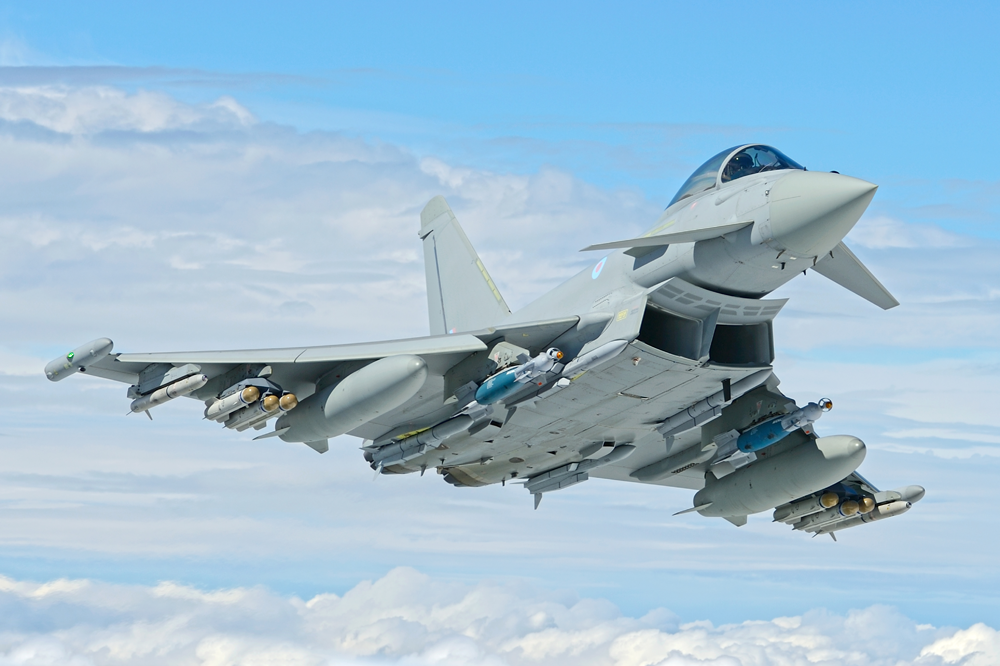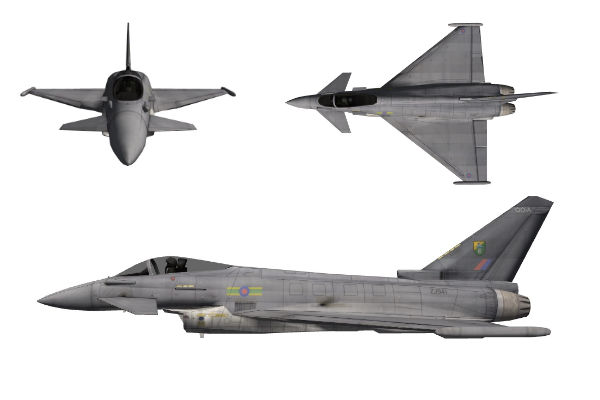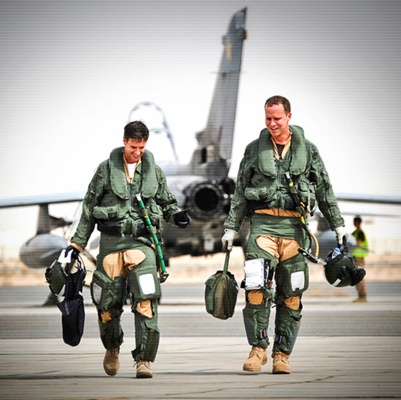About the Typhoon FGR4
ROLE
The Typhoon FGR.Mk 4 is a highly capable and extremely agile multi-role combat aircraft, capable of being deployed for the full spectrum of air operations, including air policing, peace support and high-intensity conflict. Initially deployed in the air-to-air role as the Typhoon F.Mk 2, the aircraft now has a potent, precision multi-role capability as the FGR4. The pilot performs many essential functions through the aircraft’s hands on throttle and stick (HOTAS) interface which, combined with an advanced cockpit and the Helmet Equipment Assembly (HEA), renders Typhoon superbly equipped for all aspects of air operations.
Although Typhoon has flown precision attack missions in all its combat deployments to date, its most essential role remains the provision of quick reaction alert (QRA) for UK and Falkland Islands airspace. Detachments have also reinforced NATO air defence in the Baltic and Black Sea regions.
CAPABILITY
With its multi-role capability and variety of weapons, the Typhoon FGR4 is capable of engaging numerous target types. In the air-to-air role it employs the infrared-guided Advanced Short Range Air-to-Air Missile (ASRAAM) and ramjet-powered, radar-guided, beyond visual range Meteor, as well as the Advanced Medium Range Air-to-Air Missile (AMRAAM). These weapons, used in conjunction with the jet’s Captor radar and PIRATE electro-optical targeting system, combine with the Typhoon’s superior performance and manoeuvrability to make it a formidable platform.
For ground-attack and close air support (CAS) missions, Typhoon is compatible with the GPS/laser-guided Enhanced Paveway II and Paveway IV bombs, and Brimstone guided missile, usually in conjunction with the Litening III targeting pod. Its regular configuration for the armed reconnaissance and CAS roles includes Litening III, Paveway IV, Brimstone and the internal 27mm gun.
Paveway IV offers cockpit-programmable impact angle, impact direction and fuse delay features for precisely tailored target effects. The 27mm gun is ideally suited to providing warning shots or for accurate attacks against targets including light vehicles and personnel.

Image by: Jamie Hunter
Header image by Sgt Ralph Merry
Specifications
Eurofighter Typhoon FGR.Mk 4:
- Powerplant: two Eurojet EJ200 turbofans each rated at 20,000lb st (90kN) with afterburning
- Length: 52ft 4¼in (15.96m)
- Height: 17ft 4¼in (5.29m)
- Wingspan: 36ft 4½in (11.09m)
- Wing area: 538.20sqft (50m2)
- Empty weight: around 22,000lb (10,000kg)
- Loaded weight: around 46,300lb (21,000kg)
- Maximum speed: Mach 1.8
- Brakes off to Mach 1.5 at 35,000ft: less than 2 minutes 30 seconds
- Maximum altitude: 55,000ft
- Armament: internal 27mm Mauser cannon; ASRAAM, Meteor and AIM-120 AMRAAM air-to-air missiles; Enhanced Paveway II and Paveway IV precision-guided bombs, and Storm Shadow and Brimstone air-to-ground missiles
Typhoon FGR4 Recognition
Interactive 3D model of the Typhoon FGR4 aircraft follows, you can interact with the model using buttons and mouse.
Drag aircraft model to view other angles
Typhoon FGR4 Recognition
We have an interactive 3D version of this recognition image, to view open this page in one of the supported browsers: Google Chrome, Firefox, Safari or Microsoft Edge.
Wings
Delta wing with foreplanes
Engine
Twin EJ200 turbofan
Fuselage
Square engine intakes^Flat bottom^15.96m total length
Tail
Single swept tail

History of the Typhoon FGR4
TYPE HISTORY
In 1979, France, West Germany and the UK embarked upon the European Combat Fighter (ECF) study, which the RAF initially hoped might inform decision making over a replacement for the Harrier and Jaguar. When it subsequently envisaged a secondary air-to-air role for the type, it also became a potential Phantom successor, but the three nations’ requirements had diversified and although proposals came from BAe, France’s Dassault and West Germany’s MBB, there was little common ground.
Meanwhile, the Panavia partner nations, responsible for creating the Tornado, embarked upon an Agile Combat Aircraft (ACA) programme, but this too foundered. Nonetheless, West Germany was now determined that a five-nation consortium, including France, Italy, Spain and the UK, remained the way ahead.
Wishing to press on in some form, in 1983 the British government ordered what was hoped would be a pair of Experimental Aircraft Programme (EAP) demonstrators, optimistically with input from Italy and West Germany. Such input was not forthcoming and BAe built only one EAP, employing RB.199 engines as used in the Tornado and an advanced aerodynamic configuration. The aircraft was hugely impressive and remarkably close in layout to the machine that eventually emerged as the Eurofighter Typhoon.
Italy, Spain and the UK saw EAP as the basis of a fighter that would satisfy all their requirements, while France pushed for the Dassault ACX concept originally submitted against the ECA requirement, and West Germany was keen to keep the five partners together. France decided to go its own way in 1985, eventually maturing ACX into the superlative Rafale, while the remaining nations agreed a specification for a new fighter in December that year.
In September 1987 this became the formal specification for the European Fighter Aircraft (EFA), although huge differences in operational requirement still remained. The Eurofighter consortium of BAe, MBB, Italy’s Aeritalia and Spain’s CASA was established to develop and build EFA, receiving a development contract on November 23, 1988; Eurojet was formed to develop a new turbofan engine and EuroRADAR to design the fighter’s radar system.
Successfully negotiating the complications expected of an international programme and the challenges of creating any technologically advanced system, Eurofighter flew the initial EFA Demonstrator Aircraft (DA1) for the first time on March 27, 1994. Without radar and powered by RB.199s, this German aircraft (built by DASA, which had by now consumed MBB) enabled a start to test work, an effort fortified on April 6, when BAe’s similarly configured DA2 took off for its maiden flight.
Italy’s DA3 was next up, on June 4, 1995, built by Alenia (established in 1990 by the merger of Alitalia and Selenia) and equipped with Eurojet EJ200 engines, but still without radar, followed by the first two-seater, Spain’s DA6, on August 31, 1996. Alenia flew DA7 on January 27, 1997 and DASA’s DA5, the first example built with the ECR-90 radar, flew on February 24, 1997; back in the UK, BAe had delayed DA4’s first flight until March 14, 1997 so the radar could be installed.
With the full development fleet flying, thoughts turned to production. It was decided that the aircraft would be produced in three ‘Tranches’, each of increasing capability, within which ‘Batches’ would provide incremental advances in performance through smaller numbers of aircraft built in ‘Blocks’. Thus, Tranche 1 was defined as three Batches built as Blocks 1, 2 and 5. In 1998 it had also been determined that the aircraft would be named Typhoon for export customers and the RAF, Tifone by the Italians and Tifón by Spain; it is the EF2000 in German service.
A series of five Instrumented Production Aircraft followed, with Alenia’s IPA2 first into the air, on April 5, 2002. By now, DASA had become part of EADS, which flew IPA3 on April 8, followed by BAE Systems (which had absorbed BAe) with IPA1 on April 15, all of them two-seaters. Single-seaters IPA4, built by what was now EADS CASA, and BAE Systems’ IPA5 flew on February 27 and June 7, 2004, respectively, paving the way for full production.
Service Entry
In the meantime, Four Nation Type Acceptance had been granted on June 30, 2003, enabling a start to UK-specific testing, in particular with 17 (Reserve) Squadron, the Typhoon Operational Evaluation Unit, which had re-formed at BAE Systems’ Warton facility on September 1, 2002 and received its first Typhoon there on December 18, 2003. In September, 29 (Reserve) Squadron also formed at Warton, as the nascent Typhoon operational conversion unit (OCU), with aircraft seen in its distinctive markings from the following May.
Working closely with BAE Systems, these two units prepared the Typhoon, its crews and support personnel for service, both squadrons moving to RAF Coningsby in spring 2005. There the Typhoon frontline began to form on April 1, 2006, when 3 (Fighter) Squadron re-formed as the jet’s first operational unit, becoming active three months later.
In service, the initial Tranche 1 aircraft were designated Typhoon T.Mk 1 for the two-seaters and F.Mk 2 for the single-seaters, their equipment fit limiting them to the air defence role, albeit to a level never before seen in UK skies. With this capability, the Typhoon F2 took over responsibility for UK QRA on June 29, 2007.
The Typhoon had been developed and promoted as a ‘swing-role’ platform, meaning it was equipped with sensors and weapons suitable for multiple roles in a single mission. This complex capability was to be expressed incrementally through the production programme but, with the possibility of a Typhoon deployment under Operation Herrick, the UK added an austere air-to-ground capability to its Tranche 1 jets from 2008, modified aircraft introducing the T.Mk 3 and FGR.Mk 4 designations. Equipped with the Litening III targeting pod and Paveway II laser-guided, or Enhanced Paveway II laser/GPS-guided bombs, these aircraft were ultimately not required in Afghanistan. While the UK was introducing air-to-ground capability to Tranche 1, BAE Systems had begun delivering Tranche 2 jets to RAF Coningsby. Four of these machines flew to the Falkland Islands, where they relieved the Tornado F3 of its long-standing air defence duties in September 2009.
Capability Enhancement
Typhoon development has continued in carefully executed phases, as was always the intention, through a process known as spiral upgrade. This received additional impetus from Project Centurion, which transferred core Tornado GR4 capability onto Typhoon ready for the ‘Tonka’s’ March 2019 out of service date. Paveway IV had been operational on Tranche 2 Typhoon for some time, Project Centurion adding Storm Shadow and Brimstone, with Meteor integrated more or less simultaneously.
Having first deployed into combat for Operation Ellamy (over Libya) in 2011, Typhoon Force began an enduring commitment to Operation Shader (Iraq/Syria) in December 2015. It has also been a regular contributor to the Baltic Air Policing effort under Operation Azotize and bolstered NATO air defence over the Black Sea, deploying jets to Romania, and Iceland, in addition to the standing commitment of QRA in the UK and Falkland Islands.
Typhoon Force currently stands at five frontline squadrons, plus the OCU, IX (Bomber) Squadron, providing QRA and aggressor training, 12 Sqn, a joint UK-Qatari unit, and 41(R) Test & Evaluation Squadron (TES), which operates a small Typhoon fleet under the Air & Space Warfare Centre.
















